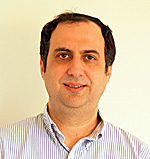By Morris Malakoff, JTNews Correspondent
The passage of time does not diminish the importance of the beliefs, teachings and tenets of a religion. But time can make those same elements seem out of context, outdated, boring and bordering on the irrelevant.
Rabbi Jonathan Sacks believes he has a solution that will put Judaic education in a context that makes it relevant to a generation of students that is more likely to seek knowledge from the Internet than from a thick tome of dry text.
In his position as the new principal of Judaic Studies at the Seattle Hebrew Academy, Sacks is putting in place an integrated program that he says gives “identity and connection” to classic theological teachings.
“This is an educational system that combines what is taught in Judaic education with what students are learning in their regular classes such as science, social studies and language arts,” he said.
As a teacher and administrator in Jewish schools in Long Island, N.Y. for the past 17 years, he said he has heard firsthand from students and parents about years of tuning out the often dry, formalized teaching that dominates Judaic studies.
“That is a system that comes from European roots,” he said. “For generations, that worked because students lived in villages and communities where what they learned in school was easily seen in practice outside the classroom.”
But more than a century of navigating the twin currents of a rapidly modernizing society and integration into the broader community has meant that even the most basic lessons can seem more myth than fact to many Jews in today’s society — starting with the youngest ones.
“The story of Hanukkah is a good example,” Sacks said. “People don’t use oil lamps much anymore and most students have never seen oil burned in any form.”
To illustrate that lesson, Sacks says he might integrate that story with a science lesson.
“The science teacher can demonstrate oil used for heat and light as well as discuss the science behind it,” he said. “Now, the burning of oil is no longer an abstract idea, but one that makes sense. The student has context for the lesson of Hanukkah and a science lesson as well.”
For younger students, Sacks said, something like a basic field trip to the zoo is great for a lesson in kashrut.
“You can show students what an animal with a cloven hoof looks like,” he said. He points to a similar lesson that comes without a tangible demonstration, like a science lab or field trip.
“A class could be studying the concept of free will,” he said, “and they could bring in a current event topic as a point of discussion.”
Sacks illustrated with the case of John Muhammed, the Tacoma man who led a young boy on a Washington, D.C. shooting spree in 2002.
“For students familiar with that incident, it is something that they can identify with,” he said. “It is something they can imagine because it is a contemporary example. They can examine the issues that not only come with that as a current event, but can then go to what they are being taught about concepts such as free will in the context of their Judaic studies.”
Sacks said that this particular type of educational programming in and of itself is not new. It has been done for a number of years in general education, combining science with language arts, for example. But in Judaic studies, he said it is not something he is aware is used on a widespread basis.
Sacks was hired following a nationwide search to take over for Rivy Poupko Kletenik, who had been doing double duty as head of school and Judaics principal. Kletenik remains as head of school.
“After some time it was apparent that even Rivy can’t do two jobs,” wrote Joanna Sandorffy, SHA’s board president, via e-mail. “Our head of school, with input from the board of directors, chose Rabbi Sacks as the most qualified candidate and best fit for SHA.”
It’s an arrangement, Sandorffy wrote, that she hopes lasts for several years.
Since arriving at the beginning of the school year, Sacks said he has already seen positive results and that the SHA community appears to be embracing his methods. In fact, he would one day like to bring the teaching of Judaic studies through the melding of traditional teachings with modern-day examples to adults as well.
“I think that in time, that is something I would like to explore,” he said. But for now, he said, he is busy with SHA’s primary focus: The kids.
A Pittsburgh native, Sacks has a degree in political science, an academic path that almost led him from ever moving on to his rabbinical training in New York and into Judaic education.
“As I was finishing my degree, I went through the recruitment process to be an analyst with the CIA,” he said. “They dragged their feet getting my background check done and by the time they called with an offer, I was on to other things.”
He taught in and oversaw the Judaic Education program for 16 years at the Torah Academy of Long Island, before that school closed its doors in 2006. He then taught at the Hebrew Academy of the Five Towns and Rockaway before taking the position at SHA this year.
